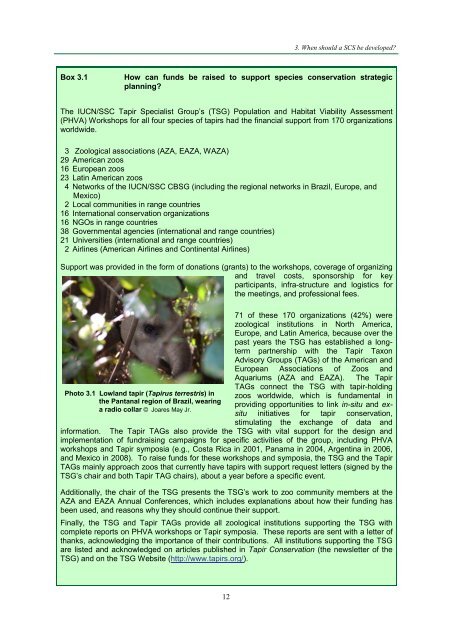Strategic Planning for Species Conservation: A Handbook - IUCN
Strategic Planning for Species Conservation: A Handbook - IUCN
Strategic Planning for Species Conservation: A Handbook - IUCN
You also want an ePaper? Increase the reach of your titles
YUMPU automatically turns print PDFs into web optimized ePapers that Google loves.
12<br />
3. When should a SCS be developed?<br />
Box 3.1 How can funds be raised to support species conservation strategic<br />
planning?<br />
The <strong>IUCN</strong>/SSC Tapir Specialist Group’s (TSG) Population and Habitat Viability Assessment<br />
(PHVA) Workshops <strong>for</strong> all four species of tapirs had the financial support from 170 organizations<br />
worldwide.<br />
3 Zoological associations (AZA, EAZA, WAZA)<br />
29 American zoos<br />
16 European zoos<br />
23 Latin American zoos<br />
4 Networks of the <strong>IUCN</strong>/SSC CBSG (including the regional networks in Brazil, Europe, and<br />
Mexico)<br />
2 Local communities in range countries<br />
16 International conservation organizations<br />
16 NGOs in range countries<br />
38 Governmental agencies (international and range countries)<br />
21 Universities (international and range countries)<br />
2 Airlines (American Airlines and Continental Airlines)<br />
Support was provided in the <strong>for</strong>m of donations (grants) to the workshops, coverage of organizing<br />
and travel costs, sponsorship <strong>for</strong> key<br />
participants, infra-structure and logistics <strong>for</strong><br />
the meetings, and professional fees.<br />
Photo 3.1 Lowland tapir (Tapirus terrestris) in<br />
the Pantanal region of Brazil, wearing<br />
a radio collar © Joares May Jr.<br />
71 of these 170 organizations (42%) were<br />
zoological institutions in North America,<br />
Europe, and Latin America, because over the<br />
past years the TSG has established a longterm<br />
partnership with the Tapir Taxon<br />
Advisory Groups (TAGs) of the American and<br />
European Associations of Zoos and<br />
Aquariums (AZA and EAZA). The Tapir<br />
TAGs connect the TSG with tapir-holding<br />
zoos worldwide, which is fundamental in<br />
providing opportunities to link in-situ and exsitu<br />
initiatives <strong>for</strong> tapir conservation,<br />
stimulating the exchange of data and<br />
in<strong>for</strong>mation. The Tapir TAGs also provide the TSG with vital support <strong>for</strong> the design and<br />
implementation of fundraising campaigns <strong>for</strong> specific activities of the group, including PHVA<br />
workshops and Tapir symposia (e.g., Costa Rica in 2001, Panama in 2004, Argentina in 2006,<br />
and Mexico in 2008). To raise funds <strong>for</strong> these workshops and symposia, the TSG and the Tapir<br />
TAGs mainly approach zoos that currently have tapirs with support request letters (signed by the<br />
TSG’s chair and both Tapir TAG chairs), about a year be<strong>for</strong>e a specific event.<br />
Additionally, the chair of the TSG presents the TSG’s work to zoo community members at the<br />
AZA and EAZA Annual Conferences, which includes explanations about how their funding has<br />
been used, and reasons why they should continue their support.<br />
Finally, the TSG and Tapir TAGs provide all zoological institutions supporting the TSG with<br />
complete reports on PHVA workshops or Tapir symposia. These reports are sent with a letter of<br />
thanks, acknowledging the importance of their contributions. All institutions supporting the TSG<br />
are listed and acknowledged on articles published in Tapir <strong>Conservation</strong> (the newsletter of the<br />
TSG) and on the TSG Website (http://www.tapirs.org/).

















